Euphorbium, Official SpurgeAfarbiyun (Ayurveda)Fariyum, Afarbiyun (Unani) |

|

|

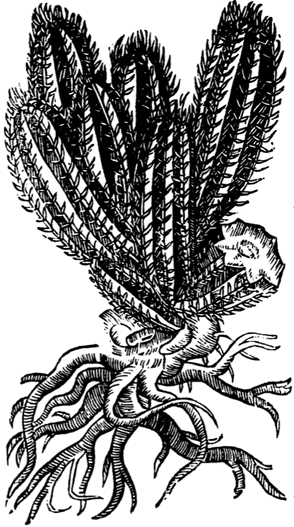
|
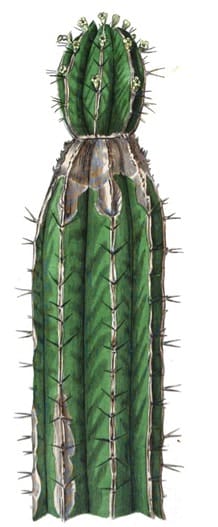
|
|
Euphorbium Parkinson, Theatrum Botanicum, 1640 |
Euphorbium Medical Botany, Stephenson & Churchill, 1831 |
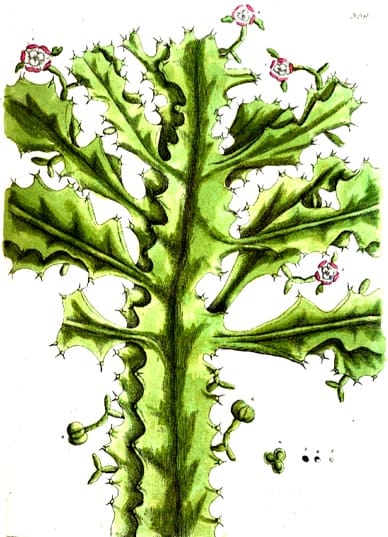
|
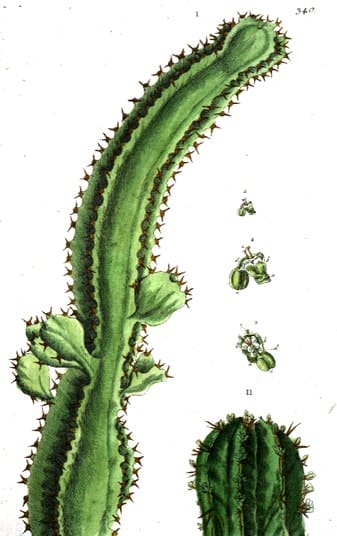
|
(Herbarium Blackwellianum, 1757)
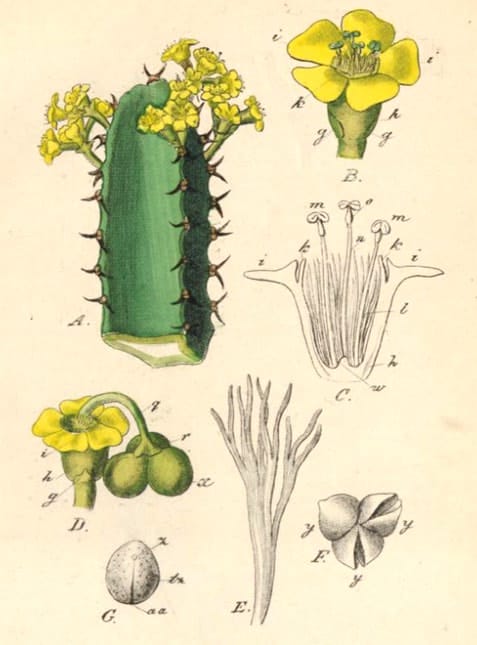 Euphorbium
EuphorbiumHand-Atlas Medicinisch-Pharmaceutischer, 1884
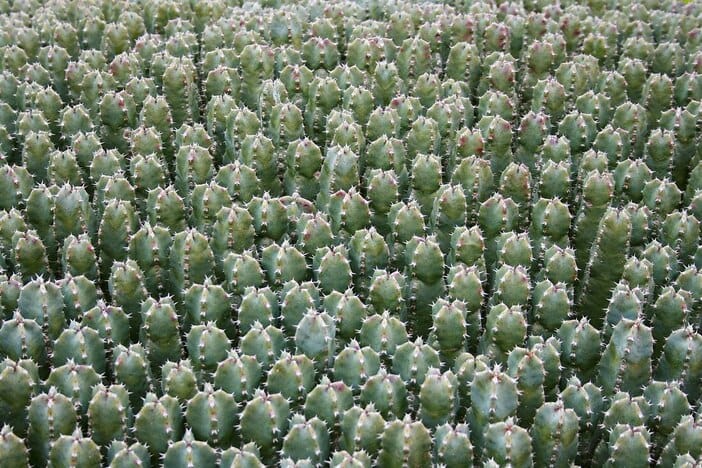 Euphorbia resinifera
Euphorbia resinifera(Photo by Frank Vincentz) (Wikimedia)
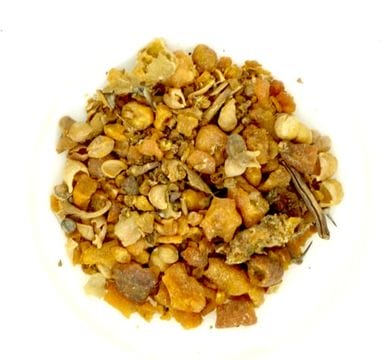 Gum Euphorbium (Adam, 2018)
Gum Euphorbium (Adam, 2018)
Botanical name:Euphorbia resinifera (syn. Tithymalus resinifer) Parts used:Dehydrated Juice; it should be prepared or at least a year old before use. The best is yellowish, clear, in small flakes or tears Temperature & Taste:Hot, dry. Pungent. Toxic. Classifications:2Q. ANODYNE 3K. EXPECTORANT 3M. ARTHRITICS 3P. MASTICATORIES & STERNUTATORIES Preparers and Purgers of Phlegm Preparers and Purgers of Melancholy |
 Traditional packaging for exporting Euphorbium
Traditional packaging for exporting EuphorbiumKrauterbuch, Lonitzer, 1578 |
Uses:
1. Strongly purges Water and Cold-Phlegm:
-serious Edema and Ascites
-Cold phlegm or Damp obstructing the Stomach, Bowels, Brain, Lungs, Joints, Nerves
-Paralysis or loss of Nerve function from Cold-Phlegm-Damp
-Cachexia; Damp-type Jaundice
2. Warms the Womb, Promotes Menstruation:
-Amenorrhea; Chlorosis
-obstructions of the Womb
-previously used to promote Labor and cleanse the Afterbirth (not used for this purpose now)
3. Externally:
-applied to hardness and tumors
-applied to cold and rheumatic joints
-applied to paralytic parts
-cautiously applied to chronic and foul Ulcers and Wounds (well diluted)
Dose:
1. Only used in compounds with other purging medicines. The Greek usually used Euphorbium in large compounds.
2. Best given in Pills.
200–500mg in Pills (traditionally 5–10 grains)
Preparation:
1. Dissolve in Vinegar of Roses, strain, evaporate, then wash with Rose water. This is much better for internal use.
2. It can also be prepared with Vinegar or Lemon juice.
3. It was sometimes prepared by being put into the hollow of a Lemon, then baked in dough. This makes it white.
4. It is better and safer after being stored for a year.
Main Combinations:
1. To purge Wind and Phlegm/Damp, Euphorbium with Colocynth, Agaric, Bdellium, Sagapen, Aloe, formed into pills with Leek juice (as in Pills of Euphorbium of Mesue). They were used for Edema, Fluid retention, Arthritis, Rheumatism, Tremors and Hemiplegia.
2. Arthritis and Rheumatism:
i. Euphorbium with Colchicum, Aloe, Yellow Myrobalan, Turbith, Bdellium, Opopanax, Rue seed, Celery seed (as in Pills of Colchicum Major of Mesue)
ii. Euphorbium with Gum Ammoniac, Sagapen, Opopanax, Sarcocolla, Mastic, Cumin, Asafetida, Orris (as in Electuary of Gums of Zenon)
3. Arthritis of the Hips and Sciatica, Euphorbium with Costus, Agaric, Castoreum, Ginger, Black Pepper (as in Antidote for Hip Pain and Arthritis of Nicholas)
4. Jaundice, Euphorbium, Dodder, Aloe, Rock Parsley (equal parts), taken in Aniseed infusion. (Galen)
5. Scrofula, Euphorbium with Aloeswood, Pearl, Spikenard, Nutmeg, Clove, Galangal, Frankincense (as in Marvelous Powder Against Scrofula)
6. Apoplexy, Euphorbium with Aloe, Bdellium, Sagapen, Colocynth, Opopanax, Gum Ammoniac, Hemlock seed (as in Pills for Apoplexy of Arnold de Villa Nova)
7. Paralysis of the Tongue, Loss of Speech: steam figs and press out their pulp. Mix in 6 grains of powdered Euphorbium. Make small pills and give to the sick to hold under their Tongue, spitting out the sputum as it comes. (The Secrets of Alexis, 1615)
8. As an Errhine, Euphorbium (1 dram), White Hellebore root (4 scruples) (Memorial Pharmaceutique, 1824)
9. As a plaster for hardness and tumors, with Gum Ammoniac, Olibanum, Mastic, Zinc oxide, Pyrethrum made into a plaster with Pitch, Turpentine and Wax. (Pharmacopoeia Wirtembergica, 1798)
Major Formula:
Pills of Euphorbium (Mesue)
Pills of Colchicum Major (Mesue)
Pills for Ascites (Renodeus)
Foetid Pills Major of Galen
Pills of Opopanax (De morbus internis curandis)
Pills for Apoplexy (Arnold de Villa Nova)
Marvelous Powder Against Scrofula (Arnold de Villa Nova)
Hiera Logadii
Electuary of Gums (Zenon)
Electuary of Frankincense (Diaolibanum) (Nicholas)
Antidote for Hip Pain and Arthritis (Nicholas)
Antidote Experienced Against Cold Gout & All Feet Pain
Antidote for Cold Kidneys and to Excite Libido (Nicholas)
Antidotum Asclepiadus Minus (Nicholas)
Antimoron (Nicholas)
Philonium Romanum Galenii
Philonium Romanum (Philonium Nicolai) (Nicholas)
Cautions:
1. Very irritating. Only used after preparation and in compound (like Pills of Euphorbium). Only used in strong individuals.
2. Not used in Pregnancy or in the very young, elderly or weak.
3. Not used in Yin deficiency.
4. Topical application can irritate or burn the skin.
Toxicity:
–On the active principles of the spurge family (Euphorbiaceae). V. Extremely skin-irritant and moderately tumor-promoting diterpene esters from Euphorbia resinifera Berg.
Antidotes:
1. Citron seed with wine
2. Emerald
3. Sealed Earth
4. Theriac
CITES listing:
Note that this medicine is endangered and listed on CITES.
Main Preparations used:
Prepared Euphorbium, Tincture, Extract, Oil and Spirit of Euphorbium, Pills of Euphorbium
1. Tincture of Euphorbium:
Externally for caries, chronic and sordid Ulcers, scrofulous engorgement, paralytic parts. Use very cautiously.
i. Euphorbium in coarse powder (1 part), Alochol 22% (4 parts), digest 3 days, strain. (Pharmacopoeia Gallica, 1818)
2. Plaster of Euphorbium:
i. Resin (4 oz.), Turpentine (6 drams), melt together and add: Euphorbium in powder (1 1/2 drams). Mix. (Pharmacopoeia Generalis, 1783)
Pliny on Euphorbium:
|
‘In the time, too, of our fathers, King Juba discovered a plant, to which he gave the name of ” euphorbia,” in honour of his physician, Euphorbus, the brother of the same Musa, whom we have mentioned as having saved the life of the late Emperor Augustus. It was these brothers who introduced the practice of douching the body with large quantities of cold water, immediately after the bath, for the purpose of bracing the system: whereas in former times, as we find stated in the works of Homer even, it was the practice to wash the body with warm water only. With reference to euphorbia, there is a treatise still in existence, written upon it by King Juba, in which he highly extols its merits: he discovered it growing upon Mount Atlas, and describes it as resembling a thyrsus in appearance, and bearing leaves like those of the acanthus. ‘The properties of this plant are so remarkably powerful, that the persons engaged in collecting the juices of it are obliged to stand at a considerable distance. The incisions are made with a long pole shod with iron, the juice flowing into receivers of kid-leather placed beneath. The juice has all the |
appearance of milk, as it exudes, but when it has coagulated and dried, it assumes the form and consistency of frankincense. The persons engaged in collecting it, find their sight improved thereby. This juice is an excellent remedy for the stings of serpents, in whatever part of the body the wound may have been inflicted, the practice is to make an incision in the crown of the head, and there introduce the medicament. The Gaetuli who collect it, are in the habit of adulterating it with warm milk; a fraud, however, easily to be detected by the agency of fire, that which is not genuine emitting a most disgusting smell. ‘Much inferior to this is the juice extracted, in Gaul, from the “chamelaea,” a plant which bears the grain of Cnidos. When broken asunder, it resembles hammoniacum in appearance; and however slightly tasted, it leaves a burning sensation in the month, which lasts a considerable time, and increases every now and then, until, in fact, it has quite parched the fauces. (The Natural History of Pliny, trans. by Bostock and Riley, Vol. 5, 1856) |
Pharmacographia, Fluckiger & Hanbury, 1879:
|
‘Euphorbium was known to the ancients. Dioscorides and Pliny both describe its collection on Mount Atlas in Africa, and notice its extreme acridity. According to the latter writer, the drug received its name in honour of Euphorbus, physician to Juba II., king of Mauritania. This monarch, who after a long reign died about A.D.18, was distinguished for his literary attainments, and was the author of several books which included treatises on opium and euphorbium. The latter work was apparently extant in the time of Pliny. Euphorbium is mentioned by numerous other early writers on medicine, as Rufus Ephesius, who probably flourished during the reign of Trajan, by Galen in the 2nd century, and by Vindicianus and Oribasius in the 4th. Aetius and Paulus Aegineta, who lived respectively in the 6th and 7th centuries, were likewise acquainted with it; and it was also known to the Arabian school of medicine. In describing the route from Aghmat to Fez, El-Bekri of Granada, in 1068, mentioned the numerous plants “El-forbioun” growing in the country of the Beni Ouareth, a tribe of the Sanhadja; the author noticed the spiny herbaceous stems of the shrub abounding in the purgative milky juice. Host (1760-1768) stated that the plant, which he also |
correctly compared with Opuntia, is growing near Agader, south of Mogador. The plant yielding euphorbium was further described at the beginning of the present century by an English merchant named Jackson, who had resided many years in Morocco. From the figures he published, the species was doubtfully identified with Euphorbia canariensis L., a large cactus-like shrub, with quadrangular or hexagonal stems, abounding on scorched and arid rocks in the Canary Islands. In the year 1749 it was pointed out in the (Admiralty) Manual of Scientific Enquiry, that the stems of which fragrants are found in commercial euphorbium, do not agree with those of E. canariensis. Berg carried the comparison further, and finally from the fragments in question drew up a botanical description, which with an excellent, figure he published as Euphorbia resinifera. The correctness of his observations has been fully justified by specimens which were transmitted to the Royal Gardens, Kew, in 1870, and now form flourishing plants. The drug has a place in all the early printed pharmacopoeias. |
–Euphorbium: modern research on its active principle, resiniferatoxin, revives an ancient medicine.
–[Chemical constituents of triterpenoids from Euphorbia resinifera].
–Resiniferatoxin Hampers the Nocifensive Response of Caenorhabditis elegans to Noxious Heat, and Pathway Analysis Revealed that the Wnt Signaling Pathway is Involved.
ANTIOXIDANT
–Antioxidant activity and enzyme inhibitory potential of Euphorbia resinifera and E. officinarum honeys from Morocco and plant aqueous extracts.
ANTICOAGULANT / ANTITHROMBOTIC
–Roles of a protease from Euphorbia resinifera latex in human anticoagulant and antithrombotic activities.
PROTEOLYTIC
–Sequence analysis and crystal structure of a glycosylated protease from Euphorbia resinifera latex for its proteolytic activity aspect.
ENZYME INHIBITION
–Antioxidant activity and enzyme inhibitory potential of Euphorbia resinifera and E. officinarum honeys from Morocco and plant aqueous extracts.
CANCER
–Ethnopharmacological Survey of Herbal Remedies Used for the Treatment of Cancer in the Greater Casablanca-Morocco.
ANTILEISHMANIAL / ANTITRYPANOSOMAL
–Antileishmanial and antitrypanosomal activity of triterpene derivatives from latex of two Euphorbia species.
